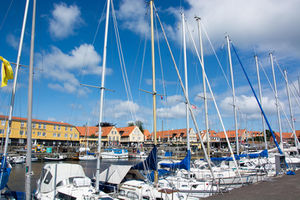Specialty tourism
| Specialty tourism |
|---|
| See also |
Specialty tourism concept, also called qualified tourism or adventure tourism, is growing form of activity taken by more advanced and competent people..
Practising this kind of tourism requires special equipment and special skills, readiness for many hardships, fitness preparation, ability to behave in the wild. It gives the opportunity to explore new cultures and societies that are not typical targets for ordinary tourists. Additionally it satisfies emotional needs, develops technical skills and orientation in terrain and foreign culture. Specialty tourism can be undertaken individually and collectively, in informal groups and organized forms, sometimes combined with elements of competition.
The term "qualified tourism" is derived from:
- Personal qualifications, which must be possessed by a tourist,
- qualification of tourist achievements, achieving tourism feat as compared to the sport.
Forms of specialty tourism
Hiking
Here we include both lowland and mountain tourism, which enjoy great popularity all over the world. It gives the opportunity to learn about nature, culture, monuments, landscapes, etc.. It has positive effect on human health, resulting in the strengthening of psychophysical strength. The most common routes of choice for tourists are mountain trails.
Cycling
It is another very popular form of tourism. We can distinguish cycling on-road and off-road. This kind of tourism may include a high-performance touring as well and competitive forms of activities. In temperate climates this type of tourism is rather seasonal, performed mainly in the summer.
Horse-riding tourism
It involves recreational horse riding in the special centers and in the field. There are lowland and mountain horse riding tourism. Special form of horse riding is so called hippotherapy, which is a form of rehabilitation for the disabled.
Ski tourism
This type of tourism has a nature of sport and recreation. There are two main forms of ski tourism: cross-country skiing and downhill skiing. With cross-country skiing people enhance the psychophysical strength and also allows to visit attractive places. However, the more popular is downhill skiing mainly in Europe and North America.
Spelunking - speleological tourism
This form of tourism involves exploring caves. Caves usually are prepared and have equipment, such as: lighting, stairs, paths, elevators, are various security measures. Sightseeing in caves is usually guided. In the caves there is not a humid climate and no allergens in the air and thus some of the caves are used for the treatment of diseases, particularly of respiratory tract.
Sailing tourism
Sailing until recently was the exclusive tourism, and even today it is costly. To enjoy sailing people have gain a lot of knowledge on the subject and have confirmation of ownership of the patent or sailor helmsman.
Diving tourism
As a sport and hobby began to spread in the XXth century. Today diving is very popular and widely available tourist activity. It provides an immerse sensations and beautiful views. The most popular areas recommended for novice divers are:, the Red Sea, Caribbean sea, Indian Ocean, Thailand.
Other forms of tourism are described in the extreme tourism article.
References
- Weber, K. (2001). Outdoor adventure tourism: A review of research approaches. Annals of Tourism Research, 28(2), 360-377.
